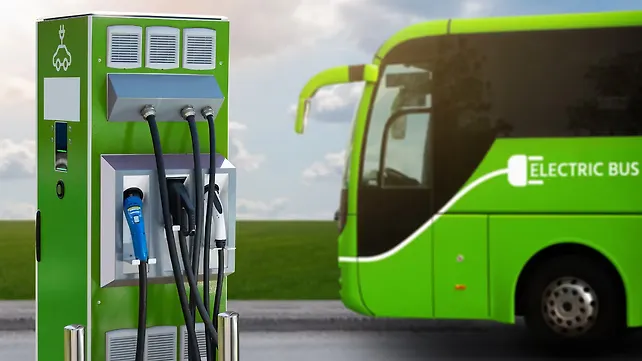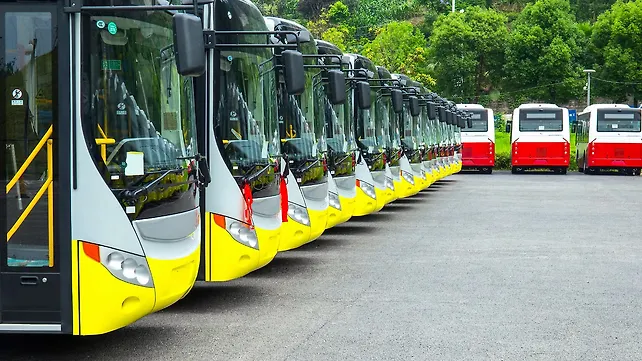
Even though different state transport undertakings (STUs) have started deploying electric buses (e-buses) in their fleet, buoyed by the impetus provided by phase I and II of the FAME scheme, there are considerable challenges that fleet operators face in doing so.
A recent report by the Center for Study of Science, Technology and Policy (CSTEP) titled ‘Planning Tool for E-Bus Deployment’ highlighted that the switch from conventional ICE buses to e-buses involves a seamless transition to public e-mobility, which essentially has two main requirements – an efficient charging infrastructure and a robust planning process.
In this context, CSTEP has developed a web-based planning tool ‘E-DEPOT’ (E-bus Depot Planning and Operations Tool) to help STUs and electricity distribution companies (DISCOMs) in taking sound decisions regarding the deployment of e-buses. The tool provides multi-level analysis (at the schedule, depot, and operations level), with specific outputs at each level to guide the planning specific to that level.
Executive Summary
Phase II of the Faster Adoption and Manufacturing of (Hybrid &) Electric Vehicles (FAME) India is envisioned to introduce 7,000 e-buses across the country by 2024. This initiative has increased e-bus deployment at a rapid rate. However, the traditional bus operators are not yet familiar with the operational needs of e-buses.
Unlike traditional buses that require refuelling, e-buses need frequent recharging to increase their operational range. This key difference calls for setting up the necessary electric infrastructure to meet the charging demand of e-buses.
Charging even a small e-bus fleet would have a significant impact on the local power demand handled by the DISCOMs. Therefore, estimating the additional power demand generated by charging e-buses is crucial for DISCOMs to plan their infrastructure.

E-DEPOT has been developed to aid the decision-making process of STUs and DISCOMs, regarding the deployment of e-buses. This version of the tool aims to assess the depot-based charging requirements, considering the existing fleet operations. It performs a feasibility analysis to identify schedules (buses on a specific route) that are suitable for e-bus deployment. The resultant power and energy consumption in charging these e-buses at the selected depots is also estimated. Hence, with the relevant inputs, this generic tool can formulate e-bus charging plans for different Indian cities.
The depots and schedules selected for operating e-buses are the key inputs for the tool. The specifications of the e-bus and the charger models chosen, and the power-grid details are the other inputs. Using this data, the tool provides a list of schedules that can be electrified, a charging timetable, the utilisation profile of each charger, the charging-demand profile, the peak power demand, the total charging energy consumed, and the cost of charging per day at each depot.
The functions of the tool are demonstrated using data representing the public buses operating in Bengaluru. E-buses with specifications of 250 kWh of battery capacity and 200 km of operational range were considered to operate on these routes. These e-buses were considered to be charged with either a slow charger of 60 kW or a fast charger of 120 kW, depending on the halt duration available for charging.
Of the 311 schedules (operating on 24 routes) used to demonstrate the tool, only 72 are feasible and the remaining 239 are infeasible. While 72 of the infeasible schedules do not have halts at the selected depots, 161 have route lengths longer than the operational range supported by the battery, and six do not have sufficient halt time to completely charge the battery.
The tool shows that for the 72 feasible schedules operating from the four depots, a total of 16 slow chargers would be required. The electricity cost for charging these schedules, according to the corresponding charging timetables, is INR 60,360 per day. Based on the representative power-grid details used in the study, it was found that new feeders are not required for deploying e-buses at the selected depots.

Upon comparing this base case with scenarios of higher battery capacity and a provision of intermittent charging, it was observed that, for this case study, increasing the battery capacity (up to 325 kWh) is a more economically viable option than increasing the charging locations (up to three locations) for intermittent charging.
These findings indicate that the maximum battery capacity eligible for subsidy under the FAME II scheme may need to be increased. Currently, the scheme provides subsidies to e-buses with up to 250 kWh battery capacity. This is not sufficient for the bus-transit operations in metropolitan cities, where the average run is over 200 km per day. Alternatively, intermittent ultrafast charging (with power rating of at least 150 kWh) stations can be set up to cater to routes with higher daily run.
Conclusion
The working and functions of the tool have been demonstrated using representative data from an STU. Moreover, CSTEP conducted a study on e-bus charging technology solutions, which analysed charging technologies alternative to plug-in charging – battery swapping, opportunity charging, and battery-assisted trolleybus systems – to assess their technical feasibility for deployment in Bengaluru.
The analysis concluded that a combination of charging technologies may have to be used for converting a large fleet of traditional fuel-based buses to e-buses. It also noted that the feasibility of employing a specific technology is largely determined by the characteristics of public transit operations, route characteristics, power infrastructure, and the nature of investments, which are not the same for all cities/states.
As such, for a successful transition to public e-mobility, customised action plans should be prepared by cities/ states, taking into account the characteristics discussed in the study. The framework and the tool developed by CSTEP can be easily adopted across the country. With a significant potential for replication and scale-up, they can help smoothen as well as accelerate India’s transition to clean public mobility.
Contributors: Spurthi Ravuri, Dr Vinay Kandagal, Aswathy KP, Arunesh Karkun
Citation: CSTEP. (2021). Planning tool for e-bus deployment. (CSTEP-RR-2021-09).